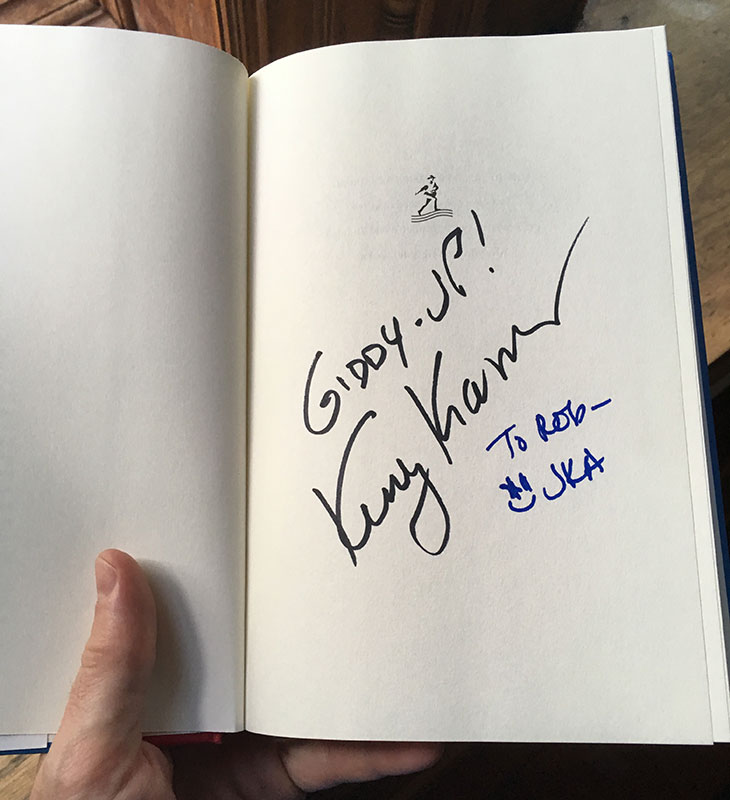I would say that I witnessed three genuine television phenomenons in my lifetime. The first was Cheers, which I still believe is the best classic sitcom ever created. The final scene of the show where Sam says, “sorry, we’re closed” and then adjusts the Geronimo portrait, which hung in the dressing room of deceased cast member Nicholas Colasanto who played Coach, still gives me chills. The third was Friends. I was a fan immediately and this show was not popular at all that first season. It was on at 9:30 on Thursdays and often got preempted by local programming. I watched as it went from charming nineties sitcom to cultural phenomenon to a subpar sitcom kept afloat by its previous success and a parade of special guest stars.
In the middle, however, was Seinfeld. In order to grasp what made Seinfeld such an inimitable, genre-defying classic, might I suggest picking up a copy of Seinfeldia. If this book had just been bits of trivia and behind the scenes stories, that would have been cool with me but the book goes further and posits the concept of “Seinfeldia.”
There’s Seinfeld trivia. The cafe where they eat, Monks? Most Seinfeld fans know that the exterior shot is a restaurant in Harlem called Tom’s Restaurant and it’s where Suzanne Vega wrote Tom’s Diner (here’s the remix because it’s dope). The diner where they actually conceived of the show is called the Westway Diner on 9th Avenue between 42nd and 43rd. When he was doing stand-up, Larry David used to look out at a crowd and decide it wasn’t worth it and walk off stage. He wrote one season of SNL where he quit and came back like nothing had happened. He wrote on Fridays where he met Michael Richards. That’s trivia.
Things can also be Seinfeldish. That’s where another sitcom tries to ape the style of dialogue from Seinfeld. Friends tried pretty hard to do this in its early seasons. “The Friend Zone” was first hypothesized (for me, anyway) in an episode of friends. Joey tells Ross he’s in the friend zone to which Ross replies, “There’s no zone!” That’s Seinfeldish.
Seinfeldia, however, is different. As the book states, “there was reality; there was television; and there was Seinfeldia, where elements of both commingled.” As writer Alec Berg observed, “When the show started interacting with the world, we’d start interacting with that interaction.” This is the stuff of an eighty page David Foster Wallace essay. Author Jennifer Keishin Armstrong’s book is luckily much more enjoyable to read.
Seinfeldia is when classic “that guy” actor Larry Hankin plays the part of an actor playing Kramer in the show within a show when, in fact, classic “that guy” actor Larry Hankin auditioned for the role of Kramer and lost it to Michael Richards.
Seinfeldia is when ex-NBC executive Jeremiah Bosang auditions for the role of Jeremiah Bosang in the show within a show episode (and doesn’t get it).
Seinfeldia is when Kramer creates a tour around New York that is based on the real life Kenny Kramer’s Seinfeld tour. The fictional character raises the profile of the real guy who in turn influences the show. That’s Seinfeldia.
Seinfeldia is also when in 2006 Kenny Kramer got hate emails after Michael Richards – the actor who no longer played the character that was based on him – went on his racist rant at the Comedy Store.
Don’t worry, there are some great bits of trivia in here but it’s the Seinfeldia that makes Seinfeldia worth the read.
This book is also about writers and ideas. Behind the whole show was Larry David’s mantra of “No hugging, no learning.” He comes off in the book (and in the Kindle Single this book inspired me to finish – Fred Stoller’s My Seinfeld Year) as pretty Larry David-ish (i.e. a George Costanza slash Larry David on Curb hybrid on a deadline). The book also perfectly states the quality of the show after David’s departure as having “lost David’s complexity and darkness” in favor of “a more absurd, cartoonish approach.”
David and Seinfeld aren’t interviewed in the book, so, you get the perspective from all of the writers who came and went during the show, particularly Peter Mehlman, a rare, multi-year member of the writing staff. I also really liked that we got to hear from Monica Yeats, an ex of Larry David’s and daughter of Revolutionary Road author and consummate writer’s writer Richard Yeats who inspired the Lawrence Tierney character in “The Jacket.”
The book left me wondering what makes a great Seinfeld idea. Much like Steve Jobs agonizing over the radius of the iPhone corners, Seinfeld and David just seemed to know their storylines when they heard them. The writers pitched and pitched and pitched some more. They mined their own lives or, in the case of Dan O’Keefe’s family’s celebration of Festivus, had their lives mined for ideas.
Seinfeldia touched on Seinfeld ideas by looking at two Twitter accounts: SeinfeldToday and Seinfeld2000.
Personally, I thought SeinfeldToday was hilarious. I was disappointed when both David and Seinfeld said that they didn’t like it. They both said, essentially, that it’s hard to come up with these show ideas and not anyone can do it, which I found to be such a confoundingly tone deaf response. For Christ’s sake even Lin Manuel Miranda liked Spamilton and, frankly, as the writer of the finale, Larry David should lighten up a bit about great storylines. The point wasn’t to resurrect the show, it was just a fun riff on the characters and situations.
I hadn’t heard of Seinfeld2000 until reading Seinfeldia but apparently someone else thought that SeinfeldToday was a weak homage to Seinfeld and started his own absurdist twitter account as a middle finger to SeinfeldToday. I guess I never loved Seinfeld enough to feel like I had to defend its honor but to each his own. But in true Seinfeldia fashion, it should be noted that Twitter wasn’t even founded until 2006, eight years after Seinfeld’s last episode.
I actually don’t know if it’s a conflict of interest to not disclose the fact that I know Jennifer Keishin Armstrong and have used her writing coach services but, well, I do and I did. So, I went to the release party at Word in Greenpoint, Brooklyn. It was cool to watch some clips and hear a discussion of the show. About halfway through, Kenny Kramer, the “real” Kramer, came down the stairs, making his scene stealing entrance. It actually struck me as rude to steal focus like that but I still wanted to get his autograph because, hell, it’s the real Kramer. It seems like the move of a guy who wants to keep his persona going so it benefits his tour scheme. His signature was far bigger than the author’s. Yeah, I can see this guy busting into someone’s apartment and stealing food from his fridge.
I wouldn’t classify seeing Kenny Kramer as Seinfeldia, it’s more just Seinfeld trivia. Still cool, though.





